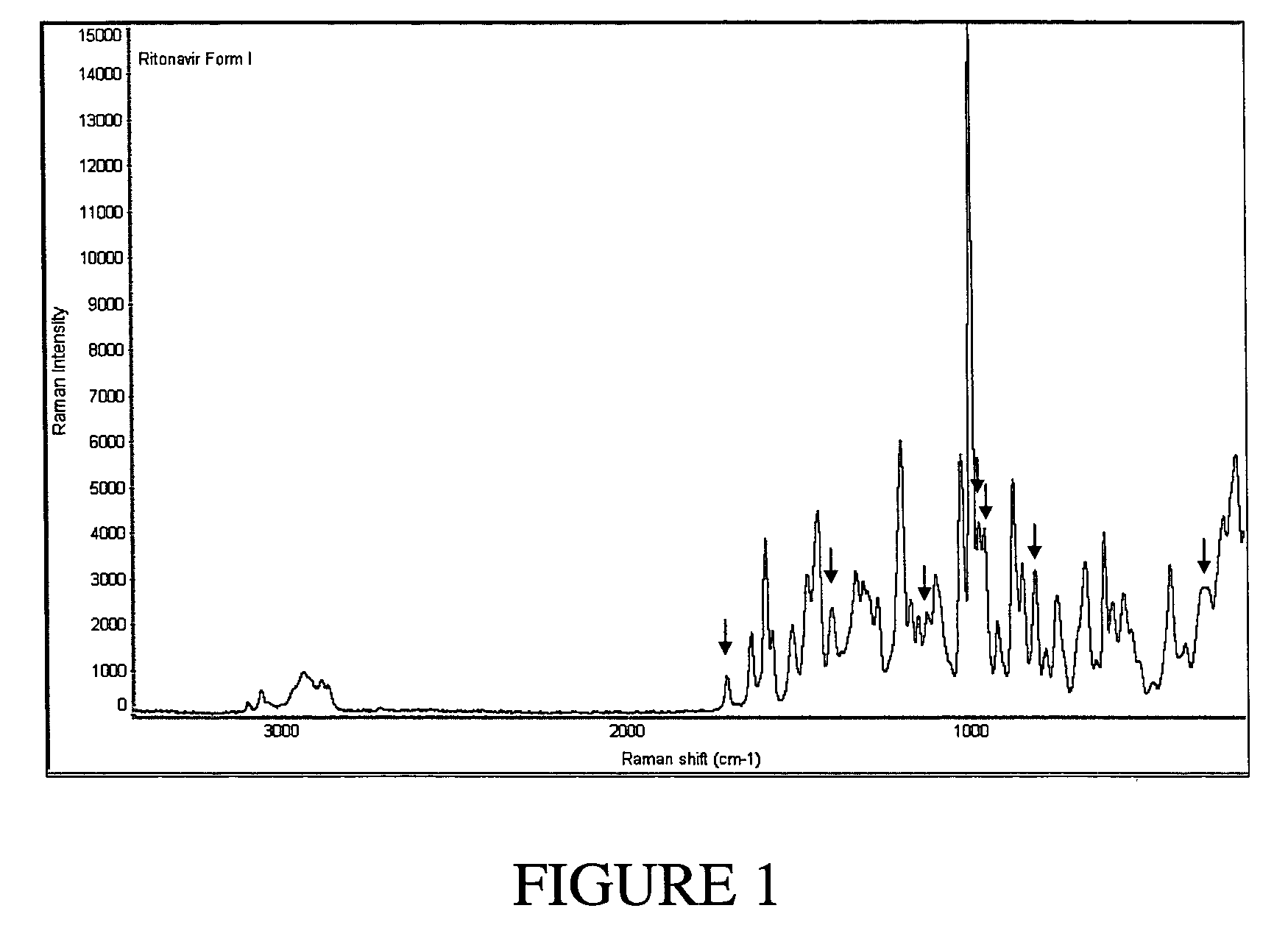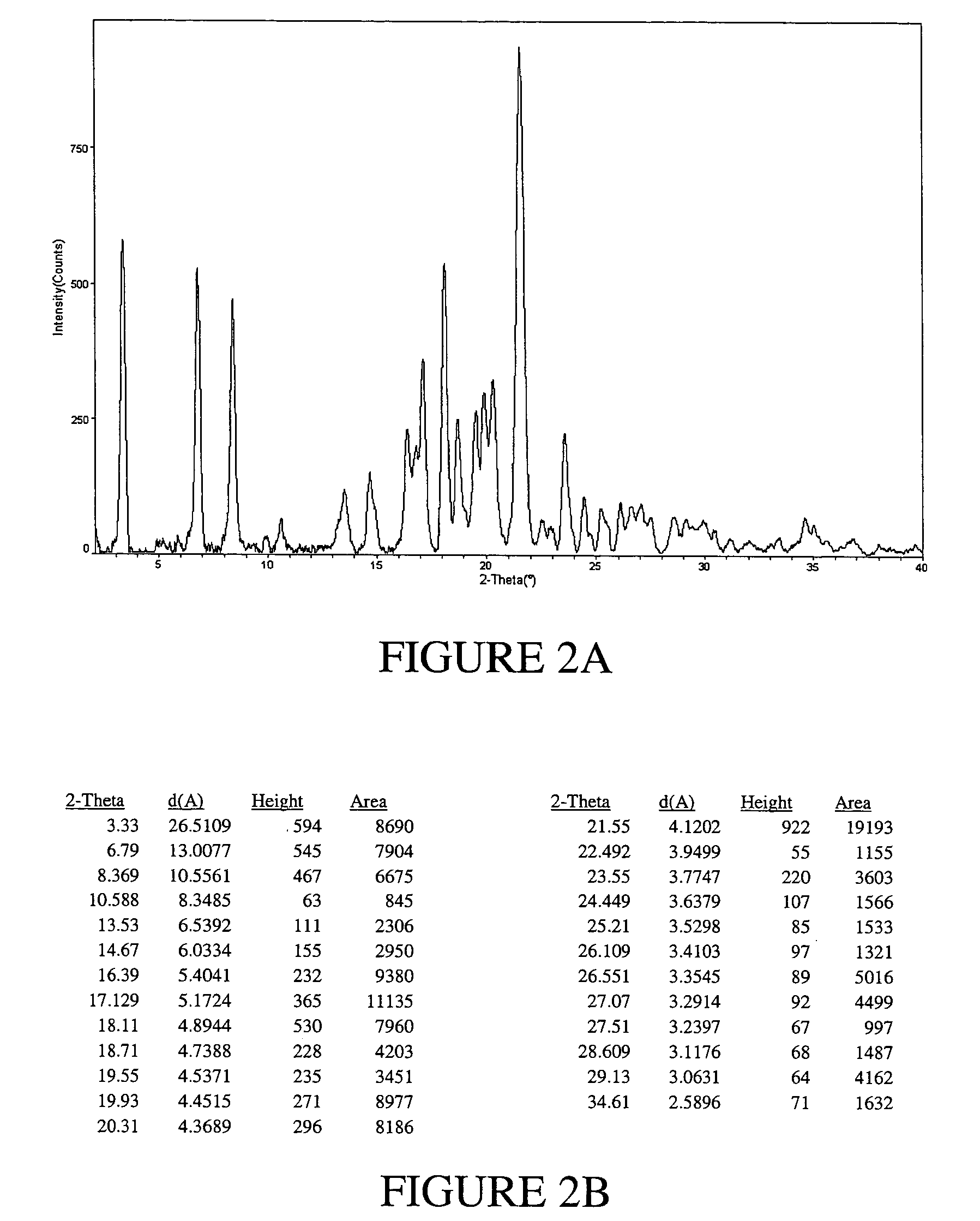Solvates and polymorphs of ritonavir and methods of making and using the same
a technology of ritonavir and polymorphs, which is applied in the field of crystal forms of ritonavir, methods of making and using the same, can solve the problems of product failure to meet the dissolution specification mandated by the regulatory agencies, and threaten the supply of drugs, and achieve the effect of enhancing the pharmacokinetic profiles of other pharmaceutically active compounds
- Summary
- Abstract
- Description
- Claims
- Application Information
AI Technical Summary
Benefits of technology
Problems solved by technology
Method used
Image
Examples
example 1
5.1. Example 1
Preparation of Ritonavir Form I
[0097]NORVIR-brand Ritonavir (Abbott Laboratories, North Chicago, Ill. USA) oral solution was used to obtain Ritonavir Form I. Specifically, approximately 240 mL of NORVIR solution (the contents of a normal prescription bottle, totaling about 19.2 g of Ritonavir) were placed into a 500 mL round bottom flask and vacuum-treated (pumping at high vacuum) for about 6 hours at room temperature on a slightly heated water bath to keep temperature constant. 50 mL of ethyl acetate was added to the viscous residue (dark orange in color).
[0098]The resulting solution was placed into a 2 liter flask and while stirring, diethyl ether was added to a final volume of about 1800 mL. The solution was stirred for 30 minutes at room temperature to allow precipitation to occur. The ether phase was poured through a 150 mL sintered glass, coarse frit funnel to clarify the ether. Successive aliquots of approx. 300 mL of filtrate were placed into a 500 mL round bot...
example 2
5.2. Example 2
Preparation of Ritonavir(III)
[0104]In order to prepare Ritonavir(III), 10 mg of Ritonavir Form I obtained in Example 1 above, 37.5 μL of formamide, and 12.5 μL of toluene (50 μL solvent total, containing 75% formamide) were deposited into a crimp-top 200 μL capacity glass vial. The vial was sealed with a crimp top and subsequently incubated at 70° C. until the Ritonavir solid dissolved. The vial was then cooled at a rate of approximately 5° C. / minute to 5° C. The vial was incubated at 5° C. until crystals were observed. The crystals in the vial were removed from the supernatant by filtration, air dried, and characterized as described herein.
[0105]Ritonavir(III) was also prepared using the same process conditions from the following mixtures: 10 mg of Ritonavir Form I, 37.5 μL of formamide, and 12.5 μL of butyl acetate; and 10 mg of Ritonavir Form I, 37.5 μL of formamide, and 12.5 μL of acetone.
example 3
5.3. Example 3
Preparation of Ritonavir(IV)
[0106]50 mg of Ritonavir(III) obtained in Example 2 above was placed on filter paper in a Buchner funnel, which was fitted to a vacuum flask connected to an aspirator. With the vacuum on, 10 mL of deionized water was slowly poured over the solid Ritonavir(III). The resulting material on the filter was dried over vacuum for approximately 15 minutes, and characterized as described herein.
PUM
| Property | Measurement | Unit |
|---|---|---|
| melting point | aaaaa | aaaaa |
| melting point | aaaaa | aaaaa |
| melting point | aaaaa | aaaaa |
Abstract
Description
Claims
Application Information
 Login to View More
Login to View More - R&D
- Intellectual Property
- Life Sciences
- Materials
- Tech Scout
- Unparalleled Data Quality
- Higher Quality Content
- 60% Fewer Hallucinations
Browse by: Latest US Patents, China's latest patents, Technical Efficacy Thesaurus, Application Domain, Technology Topic, Popular Technical Reports.
© 2025 PatSnap. All rights reserved.Legal|Privacy policy|Modern Slavery Act Transparency Statement|Sitemap|About US| Contact US: help@patsnap.com



